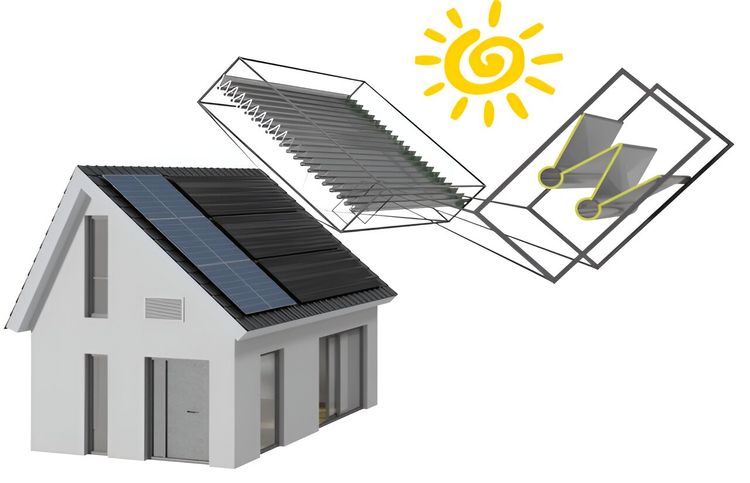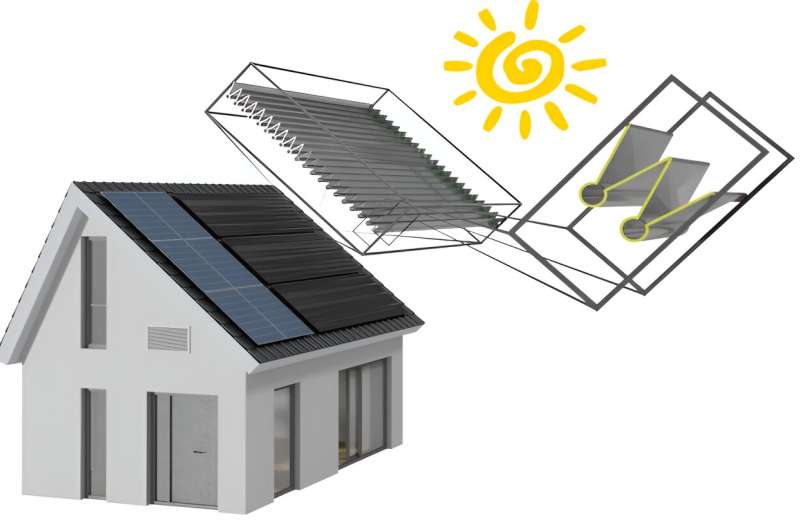New photoreactor technology could pave the way to a carbon-neutral future, researchers say

Image of the photoreactor design, suitable for installation on rooftops; the top left depicts the photoreactor panels; the top right showcases the V-shaped concentrators and tube-like cavity of the photoreactors. Credit: University of Toronto

A team consisting of experts from the University of Toronto and other countries has devised and put into action a fresh blueprint for photoreactors. These devices run on solar energy and have the capability to transform water, carbon dioxide, methane, and nitrogen into environmentally-friendly chemicals and fuels.
The cutting-edge structure enables the photoreactor to efficiently capture light particles from different angles of sunlight, eliminating the requirement for solar tracking. Moreover, the panels can be produced using polymer extrusion, making them cost-effective and easily producible in large quantities. These advantages have the potential to contribute towards making a sustainable future more accessible and feasible in terms of affordability and practicality.
Geoffrey Ozin, a professor at the University of Toronto's chemistry department in the Faculty of Arts & Science, and his team joined forces with scientists from the Karlsruhe Institute of Technology (KIT) in Germany for this undertaking.
According to Ozin, solar panels are well-known for their ability to effectively and affordably convert sunlight into environmentally friendly electricity, thereby avoiding the reliance on fossil fuels that release greenhouse gases.
In contrast to thermoreactors, photoreactors utilize sunlight and reactants to produce environmentally-friendly chemicals and fuels. These photoreactors have the potential to significantly decrease carbon emissions by harnessing the power of sunlight and water.
Despite the promise they hold, numerous photoreactors have encountered various obstacles, such as the steep expenses associated with constructing materials. Moreover, they can prove ineffective in efficiently transforming photons into products. In order to accomplish these photochemical transformations, photoreactors depend on a photocatalyst, a substance that absorbs light and transforms a reactant into a product.
Nevertheless, unproductive procedures caused by the reflection, dispersion, passage, and assimilation of light through the photocatalyst and photoreactor substances can lead to the wastage of energy. Photoreactors could obtain advantages from a sun-tracking mechanism, a tool that modifies the angle of the photoreactor based on the sun's location to achieve the most efficient utilization of light.
In order to be considered practical in terms of technology and finances, the efficiency of converting photons to products in photoreactors needs to be at least 10%. Although there have been notable developments in the past ten years regarding the incorporation of photocatalysts into photoreactors for the production of environmentally friendly chemicals and fuels, the overall efficiencies have stayed quite low, frequently reaching one percent or even less.
Ozin's crew and the team from KIT, comprising of postdoctoral researcher Paul Kant, PhD candidate Shengzhi Liang, research scientist Michael Rubin, and Professor Roland Dittmeyer,constructed a photoreactor which resembles a panel. This innovative photoreactor houses manifold microscale reaction channels running parallel to each other. The encouraging outcomes of their proposed prototype were documented in a publication titled Joule.
One important aspect of their design is that every reaction pathway is linked to a light-capturing unit in the shape of a V, which directs the light into the pathway where the photocatalyst is positioned. The surfaces of the unit are extremely reflective, ensuring the efficient transfer of photons from the external light source to the photocatalyst within the microchannels without any significant loss of light.
The revolutionary structure enables the photoreactor to efficiently gather photons from different angles of the sun, eliminating the necessity for sun tracking. Moreover, the panels can be produced by polymer extrusion, rendering them cost-effective and easily manufacturable on a large scale.
In the upcoming years, modifications in design can tackle the problem of irregular sunlight by incorporating light-emitting diodes into the photoreactor as the primary source of photons. These diodes will be powered by renewable electricity generated through photovoltaic systems and supported by lithium-ion batteries for uninterrupted operations throughout the day and night.
The latest photoreactors design shows superior performance compared to the current advanced photoreactors. It has the potential to be installed on the roofs of residential buildings and solar farms. Additionally, it can also be combined with photovoltaic systems to generate sustainable electricity as well as eco-friendly chemicals and fuels.
According to Ozin, this technological advancement has sparked the creation of a fresh wave of solar-driven gadgets that generate eco-friendly fuels like hydrogen using sunlight and water.
The progress occurs during a period when there is an urgent requirement to address the issue of climate change, especially since this summer witnessed unprecedented high temperatures across the globe.
According to Kant, a researcher at KIT, these solar items will take the place of their fossil-fuel counterparts and contribute to lessening our impact on the environment.
This greatly enhances the possibility of achieving our goal of a sustainable existence for humanity. Hopefully, we will manage to accomplish it within the given timeframe, avoiding significant temperature exceedances and the subsequent calamities.
Additional details: The study conducted by Paul Kant and colleagues focus on economical photoreactors that exhibit exceptional photon/energy efficiency for solar-powered synthesis. The research has been published in the esteemed journal Joule, with a DOI of 10.1016/j.joule.2023.05.006.
Reference: Researchers claim that a novel photoreactor technology has the potential to lead us towards a future that is free from carbon emissions (2023, August 10). Retrieved on August 13, 2023 from https://phys.org/news/2023-08-photoreactor-technology-pave-carbon-neutral-future.html
This text is protected by copyright. Aside from any reasonable use for the purpose of individual study or research, no portion may be copied or reproduced without obtaining written permission. The information contained herein is intended solely for informational purposes.





















